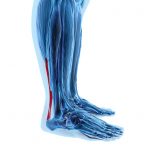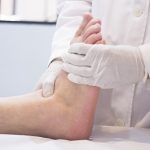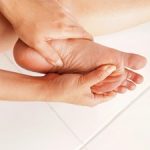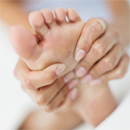Achilles tendinitis and Achilles bursitis are two types of heel pain that result from inflammation in the Achilles tendon. The Achilles tendon is a band of tissue that connects the calf muscles at the back of the lower heel to the heel bone.
The Achilles tendon is named after the Greek hero, Achilles. The mythological story declares that the tendon in Achilles’ heel was the only vulnerable part of his otherwise invulnerable body. Achilles demise occurred when the tendon at the back of his heel was shot with an arrow.
Achilles tendinitis
 Achilles tendon pain is caused by overuse, so it is most commonly seen in runners or individuals who play sports, such as tennis or basketball, on a limited basis. At-home care with a doctor’s supervision is mainly the best mode of treatment and recovery for Achilles tendinitis. In serious cases, when tearing of the tendon occurs, surgery may be required.
Achilles tendon pain is caused by overuse, so it is most commonly seen in runners or individuals who play sports, such as tennis or basketball, on a limited basis. At-home care with a doctor’s supervision is mainly the best mode of treatment and recovery for Achilles tendinitis. In serious cases, when tearing of the tendon occurs, surgery may be required.
Achilles tendon bursitis (retrocalcaneal bursitis)
This is another type of foot pain, more commonly found in runners. A bursa is a sack of fluid that sits between a tendon and the bone to help smooth movements. With repeated trauma the bursa becomes inflamed, which causes pain.
Achilles tendon bursitis is commonly confused with Achilles tendinitis, and if both conditions are present at the same time, it is known as Haglund’s syndrome.
Achilles tendinitis vs Achilles tendon bursitis (retrocalcaneal bursitis)
As mentioned, although both conditions can exist together and be confused for one another, there are some differences that distinguish the two. For example, the primary difference between Achilles tendinitis and Achilles tendon bursitis is the location of pain. Achilles tendinitis pain is situated one or two inches above where pain for Achilles tendon bursitis would be, while bursitis pain is experienced at the lowest point of the heel.
Other than the pain location difference, symptoms and treatment methods for both conditions are quite similar. A person should try not to overuse or cause impact to the heel during recovery. Physical therapy may even be required to build back strength.
Achilles heel pain symptoms and causes
 Achilles tendinitis results from overuse of the heel. When there is an increase in repetitive activity it can contribute to Achilles tendinitis. The added stress can lead to tiny tears in the fibers of the tendon, and then the tendon is unable to repair itself, which leads to pain.
Achilles tendinitis results from overuse of the heel. When there is an increase in repetitive activity it can contribute to Achilles tendinitis. The added stress can lead to tiny tears in the fibers of the tendon, and then the tendon is unable to repair itself, which leads to pain.
Aside from athletes, individuals with structural problems are also at an increased risk of Achilles tendinitis. For example, a person who is flat footed – with minimal or no arch – is at a higher risk. Laborers also have a higher risk of Achilles tendinitis compared to others.
Symptoms of Achilles tendinitis include:
- Pain – aching, stiffness, soreness and tenderness
- Tenderness or intense pain when the sides of the tendon are squeezed
- Nodules may develop with the progression of Achilles tendinitis
Achilles tendon bursitis, too, is caused by repetition or an increase in intensity, which causes the bursa to become inflamed. Risk factors for Achilles tendon bursitis include beginning an intense workout routine and suddenly increasing intensity with improper conditioning.
Symptoms of Achilles tendon bursitis include:
- Pain in the heel, especially when walking, running, or when the area is touched
- Pain that worsens when rising on the toes
- Red, warm skin on/around the area
Achilles heel pain: Exercises and stretches
 Achilles heel pain can be treated with at-home stretches and exercises in order to strengthen and improve the tendon.
Achilles heel pain can be treated with at-home stretches and exercises in order to strengthen and improve the tendon.
Achilles tendinitis stretches and exercises
Toe stretch: While sitting on a chair, extend your leg so your heel isn’t on the floor. Pull up on your big toe bringing it towards you. Hold for 15 seconds and release. Repeat a few times.
Gastrocnemius heel drop: With both feet on a step – you can use stairs and hold onto a railing for support – have your heels “hang” off the step – they should be parallel with the floor. Rise up on your toes with both feet – remember all motions should be done slowly. Then to come down lift the uninjured foot and lower yourself back to parallel with the injured heel. If being on one foot is difficult at first, raise and lower yourself with both feet to build yourself up.
Achilles tendon bursitis stretches and exercises
Foot and ankle up down: With your leg extended in front of you, point your foot away from your body and then flex it towards you. Repeat a few times.
Foot and ankle in and out: With your foot flexed pointing upwards, move your foot and ankle to flex inward and outward.
Foot and ankle circles: Try to create circles with your foot and ankle, first turning to the left and then turning to the right.
Calf stretch with towel: While sitting on the floor, extend the affected foot out in front of you. Gently wrap a towel under your foot and hold onto both ends. Gently tug on the towel, pulling your foot back as well, and then release.
Treatment and prevention of Achilles heel pain
Prevention of Achilles pain is possible if you keep the follow tips in mind:
 Increase activity level gradually.
Increase activity level gradually.- Always warm up prior to activity.
- Don’t partake in strenuous activity without warming up or avoid them at all costs.
- Choose proper shoes that offer support – if you have a structural problem, ensure you wear designated insoles.
- Stretch every day.
- Strengthen your calf muscles.
- Cross-train – don’t stick with the same form of exercise, switch it up.
Treatment can often be done at home. Here are common treatment methods for Achilles pain.
- Reduce physical activity.
- Use ice packs.
- Rest the heel.
- Strengthen calf muscles.
- Elevate your foot to reduce swelling.
- Don’t overuse the tendon.
- Wear a brace or a compressive stocking.
- Take anti-inflammatory medication.
- Wear proper shoes.
- Go to physical therapy.
- Partake in ultrasound therapy.
- Exercise and stretch regularly.
If you believe you may be experiencing the symptoms of Achilles Tendinitis with your feet, contact Achilles Podiatry for further evaluation and treatment.
Source: Bel Marra Health

